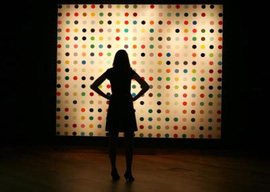
January 27, 2012

© Damien Hirst/ Science Ltd, 2012 Photography Prudence Cuming Associates
No doubt at least some in the art world gave a sigh of relief to learn that Damien Hirst’s latest retrospective, The Complete Spot Paintings, is dedicated to his innocuous colored spots. It will not feature putrefying cow heads, animal carcasses, flies, or maggots, even though the repellent and the revolting seem to hold a special charm for this young British artist.
But the fact that Hirst is in the news again brings up the two questions that lurk in the mind of all those who gag when visiting the Tate Modern: Why do wealthy collectors of contemporary art pay such outlandish sums for the objects they acquire, and why must they buy only the ugly and disgusting? Surely they could buy beautiful works of art for the same price.
In his insightful and entertaining analysis of the contemporary art market, The $12 Million Stuffed Shark, Don Thompson answers the first question:
The motivation that drives the consumer to bid at a branded auction house, or to purchase from a branded dealer, or to prefer art that has been certified by having a show at a branded museum, is the same motivation that drives the purchase of other luxury consumer goods….What the rich seem to want to acquire is what economists call positional goods; things that prove to the rest of the world that they really are rich.
So far, so good. As evolutionary psychology teaches us, the human male seeking to attract a mate must demonstrate that he will be a good provider, that he has access to the resources the female requires for herself and any offspring. During the Stone Age, a female sought a male who was a good hunter. Today, she seeks a male with plenty of money…the more money, the more access to resources. Since the invention of money, the sexiest part of a man’s body has been his wallet.
But still there is the second question: Why must this ostentatious display of wealth be made by purchasing ugly and revolting objects…the uglier and the more revolting, the better? The fact is that anyone can buy a beautiful work of art, but it takes a whole lot of money to buy something that is intrinsically disgusting and to then convince the world that the loathsome thing has great artistic and monetary value.
Money in the collector’s hands has become modernity’s philosopher’s stone. And just like the alchemists sought to convince the credulous that they could turn lead into gold, so today’s wealthy collector demonstrates his possession of the ultimate positional quality. He is the magician who can change the ugly into the artistic merely by making a purchase that proclaims to the world, “My riches have made me a master of wizardry. I can transmute putrescence into high art.” As Thompson succinctly puts it, “art history is now rewritten with a check”—and the collector with his checkbook or electronic transfer puts a Hirst or an Ofili on the same level as a Rembrandt.
Therefore, more than collectors, dealers, or artists, people such as Saatchi, Gagosian, and Hirst are really aspiring magicians. They take what is bon pour la poubelle—rotting food and flesh, excrement—and pronounce it to be not only not garbage, but high art. They remind one of the projector in Gulliver’s Travels:
His employment, from his first coming into the academy, was an operation to reduce human excrement to its original food, by separating the several parts, removing the tincture which it receives from the gall, making the odour exhale, and scumming off the saliva. He had a weekly allowance, from the society, of a vessel filled with human ordure, about the bigness of a Bristol barrel.
Swift’s projector was not successful in his endeavors, but today’s contemporary-art collectors have at least succeeded in transforming ordure into art.
So let us be thankful that at Hirst’s latest show, spots before our eyes are the most distressing things we see. These days, if you can view and smell a work of contemporary art without being forced to stifle your gag reflex, you’re already ahead of the game.